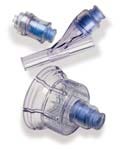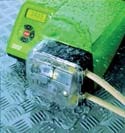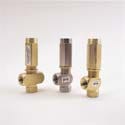Pumps and Valves 15015
November 16, 2004
Originally Published MPMN November 2004
SPOTLIGHT
Pumps and Valves
Syringe-pump components
Pumping modules are fully supported with software, electronic diagrams, and engineering phone support. This enables a designer to build prototypes or test pumping functions without sacrificing the quality of the pumping mechanism. The modular syringe-pump components come in three styles—microliter delivery, milliliter delivery, and high-force delivery. Harvard Bioscience Inc., Holliston, MA www.harvardapparatus.com
Swabbable luer valves
Swabbable luer valves were developed as substitutes for needle ports in IV applications. The needleless valves allow multiple usage, require no cap, and have good flow and low priming volume. Valve stems and bodies will mate securely with all standard luer syringes and luer connectors. All materials are gamma-resistant, USP Class VI, DEHP-free, and latex-free. The valves are available in both straight, Y-port, and vial adapter configurations. Bodies are available in polycarbonate or copolyester. Halkey-Roberts Corp., St. Petersburg, FL www.halkey-roberts.com
Peristaltic pumps
A line of peristaltic pumps have a NEMA 4¥ washdown sealed enclosure. The 520-series pumps are designed for accurate metering, dosing, and transferring of corrosive or sensitive fluids. The units provide low shear, contamination-free pumping, and predictable pump service intervals, which extend validation periods. The pump heads feature a large swept volume with low-friction stainless-steel rollers for superior accuracy. A large-diameter track and low rotational speeds ensure a long tube life and gentle handling of sensitive fluids. Watson-Marlow Bredel, Wilmington, MA www.watson-marlow.com
Ceramic, ruby, and sapphire components
High-precision pistons, valves, and other custom-made parts are available for high-pressure pumps, pipettes, and precision dispensers. Surfaces are highly polished to better than 1 µin. High-purity alumina and TZP zirconia are the most commonly used ceramics. HIP treatment is available on request for zirconia pistons. Typical applications include high-pressure pumps for analytical instruments and micropumping devices for the medical industry. Maret S.A., Bole, Switzerland www.maret.ch
Pressure regulators
A modular dovetail design enables regulators to be used individually or assembled into a modular combination of pneumatic components. Modular components include the manifold block, regulators, switches, and gauges. Dovetail push-in fittings are available in 1¼4, 3¼16, 5¼16, and 5¼32 in. and a variety of metric sizes. Standard threaded dovetails are available in 10-32 UNF, 1¼8-27 NPT, and 1¼4-18 NPT. Pressure regulators are available with adjustment ranges from 0.5 to 100 psi. The maximum supply pressure is 150 psi. Air Logic, Racine, WI www.air-logic.com
Clean valves
Bottom flush valves are designed for use on glass-lined reactors where batch-to-batch cleanliness is important. The self-draining valves allow for a variety of functions including sampling, gas dispersion, and maintenance without interrupting the process and without dismantling the valve. A glass-lined design ensures no metal contamination of the process fluid and enables use across a wide range of temperatures and pressures. The valve seat seals against the bottom outlet nozzle to prevent any collection or build-up of materials in the annular area between the valve seat and nozzle wall. An additional port with a 5° downward-sloping angle has been built into the valve to facilitate cleaning of the internal components and body. De Dietrich Process Systems, Union, NJ www.ddpsinc.com
Pressure valves
Valves prevent excess system pressure by bypassing total system fluid flow. The C46-series units contain no external springs or moving parts, are fully adjustable, and can be serviced without removing fittings or plumbing. The units are available with stainless- steel or brass bodies to suit various application needs. The design consists of a simple tapered plunger and valve seat. When excess pressure overcomes the adjustable spring pressure on the plunger, the plunger lifts off the seat, allowing fluid to bypass and reduce the pressure. The valves can handle flows up to 10 gpm and pressure to 1500 psi. Wanner Engineering Inc., Minneapolis, MN www.hydra-cell.com
Copyright ©2004 Medical Product Manufacturing News
You May Also Like

.png?width=300&auto=webp&quality=80&disable=upscale)
